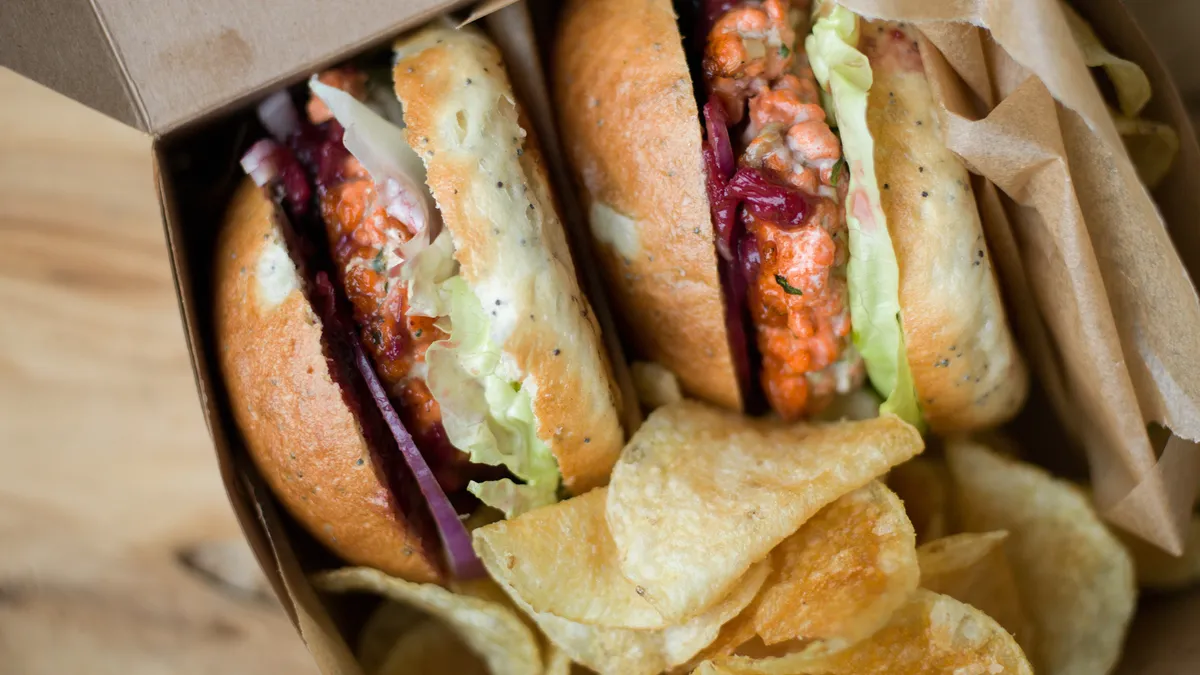When restaurants across the country closed for dine-in service because of the coronavirus, most kept going by offering takeout and delivery.
This wasn’t altogether new. Takeout and third-party delivery services, such as Uber Eats, Grubhub and Postmates, were already a huge part of food service. However, during the pandemic, 42% of the dining rooms that closed for eating-in added delivery.[1]
Consumers welcomed this option. They were locked down and eager to order online to get a taste of the outside world — and a sense of normalcy with food from their favorite restaurants.
Even now, as restaurants reopen for dining in, many consumers still prefer to order online or use a delivery service — and that trend to order online is here to stay.[2] Restaurants have responded to that trend. Nearly a third of restaurants that added delivery because of the pandemic said they believed consumers would continue wanting to eat restaurant food at home, so they plan to continue the service.[3]
Customers miss seafood
As chefs develop menus for pickup and delivery that are innovative and tasty, one excellent key ingredient to keep in mind is seafood. Customers are used to ordering fish and shellfish off the dine-in menu, and they miss that option. In fact, during the lockdown, seafood is the second-most craved dish.[4]
Seafood’s universal appeal is understandable. It is a tasty, high-quality protein with omega-3 fatty acids and a slew of other vitamins and minerals that benefit physical and mental well-being. It’s also the most environmentally friendly animal protein on the planet.
“Seafood offers a sense of exploration for the diner,” said Barton Seaver, founder and chief education officer at Coastal Culinary Academy. Take salmon, for instance. Even within a familiar category, there are different species, provenances, caught in different seasons. “Each offers its own richness,” he said. “Talk about having a fin up in the process of getting a diner excited.”
Chefs love preparing seafood
Customers aren’t the only ones who enjoy seafood: Chefs do, too. “Chefs love the diverse portfolio Alaska seafood has to offer from salmon, halibut, pollock, cod to crab, sole and so much more,” said Megan Rider, domestic marketing director, Alaska Seafood Marketing Institute. “There is a delicious and nutritious option that will appeal to every price point and cuisine.”
The diversity seafood offers is unmatched by any other animal protein, Seaver said. “It offers taste, textures, regionality, seasonality and narrative to the creative chef and extends real value.” Seafood becomes more than the foundation for a meal. It becomes an experience, he added.
While consumers love seafood, many aren’t comfortable preparing it at home and rely on dining out to get their fix. Restaurants filled that need and can stand out when they do. “Alaska seafood, for example, is synonymous with impeccable quality because it hails from the icy cold, pristine waters of Alaska,” Rider said. “When consumers see that Alaska seafood is on the menu, it validates that the restaurant cares about where they source their food. Also, more and more consumers are trying to increase their consumption of seafood versus other proteins.”
Seaver agreed. “Seafood, and the provenance that Alaska brings, is synonymous with sustainability and quality.”
Innovate by adding Alaska seafood to takeout and delivery menus
With customers wanting seafood and chefs enjoying the innovative process of preparing it, it seems natural that restaurants would add fish and shellfish to the delivery and takeout menu, but some chefs hesitate.
There are a couple of challenges to consider, Seaver said. One is to ensure the meal arrives at the right temperature but isn’t overcooked to stay warm. Another is assessing uncertain demand to make sure perishable inventory gets used.
Still, chefs can use creativity to solve these challenges, Seaver suggested. “How do you maintain a seafood meal’s integrity all the way home? Combine or pair it in composed dishes that sustain that integrity. Risotto with hot smoked Alaska sockeye salmon flaked into it. Or cannellini bean confit with salmon flaked into it. The beans maintain the heat all the way home.”
To ensure chefs have seafood at the ready, consider frozen options, Seaver said. “Frozen seafood is the future of the seafood industry,” he said. Today’s practices enable seafood to be frozen in its pristine state. “It’s a different approach that requires us as chefs to give it a fresh look.” It also gives chefs the flexibility to be creative while offering cost savings on inventory.
Although chefs may not have considered seafood for takeout and delivery before, it’s time to put it on the menu, Seaver said. “We as chefs are keepers and leaders of the food conversation in America. I consider it our responsibility to create menus purposed with sustaining people with healthy, delicious and sustainable foods, and seafood is at the top of that list,” he said.
To whet the appetite for the many options Alaska seafood offers, Seaver shares a few hints on how to prepare a successful takeout menu.
With creativity, planning and a fresh mindset, chefs can offer delicious take-home seafood meals that add a memorable twist to the menu, profitability to the restaurant and keep customers ordering again.
[1] “4 Trends Defining Delivery During COVID-19.” Restaurant Business, Aug. 4, 2020, www.restaurantbusinessonline.com/operations/4-trends-defining-delivery-during-covid-19.
[2] Kelso, Alicia. “Dine-in Traffic Improves in August, but Off-Premise Still Preferred.” Restaurant Dive, Sept. 24, 2020, www.restaurantdive.com/news/dine-in-traffic-improves-in-august-but-off-premise-still-preferred/585787.
[3] “4 Trends Defining Delivery During COVID-19.” Restaurant Business, Aug. 4, 2020, www.restaurantbusinessonline.com/operations/4-trends-defining-delivery-during-covid-19.
[4] Sanchez, Bianca. “Coronavirus and Restaurants: What Diners Miss the Most During Quarantine.” The Daily Meal, May 15, 2020, www.thedailymeal.com/what-people-miss-about-restaurants-coronavirus-quarantine/slide-3.










